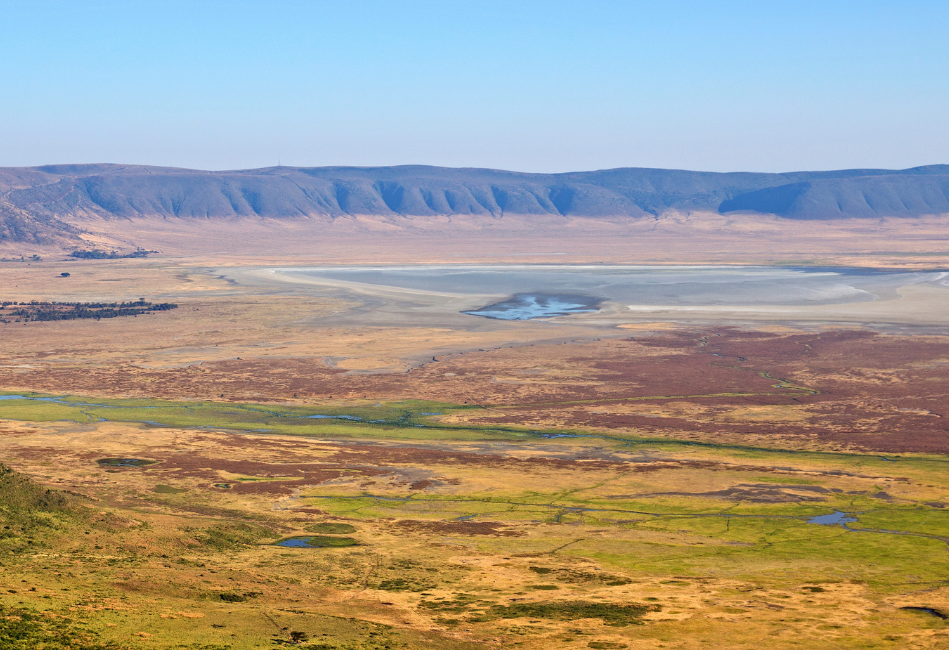Embarking on a safari adventure in Tanzania is like stepping into a world of untamed wilderness, breathtaking landscapes, and extraordinary wildlife encounters. As you prepare to explore this East African gem, you're not just planning a trip—you're setting the stage for an unforgettable African safari journey that will awaken your senses and stir your soul. Whether you're captivated by the prospect of witnessing the Great Migration in the Serengeti, eager to stand in the shadow of the majestic Mount Kilimanjaro, or dream of relaxing on the pristine beaches of Zanzibar, Tanzania offers a diverse range of experiences that cater to every adventurer's spirit. This ultimate Tanzanian safari guide is your roadmap to planning the perfect adventure, packed with essential travel information, insider tips, and exciting highlights that will ensure your safari experience is nothing short of spectacular.
Why Choose Tanzania for Your Safari?
Tanzania stands out as a premier African safari destination due to its rich biodiversity, stunning landscapes, and diverse cultural heritage. This incredible country is home to the Big Five—lions, leopards, elephants, buffalo, and rhinos—which roam freely across its vast savannahs, making Tanzania one of the best places for wildlife viewing. The annual Great Migration in the Serengeti showcases one of the most dramatic and unforgettable wildlife spectacles on Earth. In addition to its iconic wildlife, Tanzania boasts a varied terrain that includes the majestic Mount Kilimanjaro, the pristine beaches and crystal-clear waters of the Zanzibar Archipelago, and the vast, wildlife-rich plains of the Serengeti National Park, making it a must-visit destination for nature lovers and adventure seekers
The Great Migration

The Great Migration is one of the most awe-inspiring natural events on the planet. Each year, over 1.5 million wildebeest, accompanied by hundreds of thousands of zebras and gazelles, embark on a perilous journey across the Serengeti-Mara ecosystem in search of greener pastures. This cycle of life and death, marked by thrilling river crossings and dramatic predator-prey interactions, is a must-see for any wildlife enthusiast.
Diverse Ecosystems and Landscapes

Tanzania's landscapes are as diverse as they are stunning. From the snow-capped peaks of Mount Kilimanjaro to the rolling plains of the Serengeti and the lush forests of the Ngorongoro Crater, the country offers a variety of environments that support an incredible range of flora and fauna. Whether you're exploring the alkaline lakes teeming with flamingos or the baobab-studded savannahs, Tanzania's natural beauty is both mesmerizing and inspiring.
Cultural Richness

Tanzania is not just about wildlife; it's also a melting pot of cultures and traditions. The country is home to over 120 ethnic groups, each with its own unique customs, languages, and traditions. From the iconic Maasai warriors to the Hadzabe hunter-gatherers, a visit to Tanzania offers the opportunity to engage with diverse communities and learn about their ways of life.
Top Safari Destinations in Tanzania
To truly experience the magic of Tanzania, a visit to its iconic national parks and reserves is a must. Here are some of the top destinations that should be on your safari itinerary:
Serengeti National Park

The Serengeti is synonymous with African safaris. As one of the oldest and most popular national parks in Tanzania, it is renowned for its abundant wildlife and the annual Great Migration. The Serengeti's vast plains are dotted with acacia trees and home to an array of animals, including lions, leopards, cheetahs, elephants, and more. The park's diverse ecosystems, from the grassy plains to the wooded savannah, provide a perfect backdrop for incredible wildlife sightings.
Ngorongoro Crater

Often described as a natural amphitheater, the Ngorongoro Crater is the world's largest inactive volcanic caldera. This UNESCO World Heritage Site is a wildlife haven, with a high density of animals including the Big Five. The crater floor's diverse habitats—grasslands, swamps, lakes, and forests—support a wide variety of species, making it one of the best places in Africa to see wildlife up close.
Mount Kilimanjaro

Mount Kilimanjaro, Africa's highest peak, is not only a majestic natural landmark but also a bucket-list destination for trekkers around the world. The climb to the summit offers a journey through different climatic zones, from tropical forests to alpine deserts, and culminates in the stunning ice fields at the top. Whether you're an experienced climber or a first-time trekker, reaching the "Roof of Africa" is a life-changing experience.
Tarangire National Park
Tarangire National Park is a hidden gem that is often overlooked in favor of its more famous neighbors. However, this park offers unique landscapes, characterized by its iconic baobab trees and the Tarangire River, which attracts large herds of elephants. Tarangire is also known for its impressive birdlife, with over 500 species recorded. The park's less crowded nature allows for a more intimate safari experience.
Selous Game Reserve (Nyerere National Park)
One of Africa's largest protected areas, Selous Game Reserve—recently renamed Nyerere National Park—offers a wild and remote safari experience. The park's varied landscapes include miombo woodlands, savannahs, and wetlands, making it home to a rich diversity of wildlife. Selous is particularly known for its large populations of elephants, hippos, and crocodiles, as well as being a stronghold for the endangered African wild dog.
Ruaha National Park
Ruaha National Park, the largest national park in Tanzania, is a remote and rugged wilderness area that offers spectacular scenery and diverse wildlife. The park is a prime destination for spotting predators, including lions and leopards, as well as large herds of elephants. The Great Ruaha River, which flows through the park, is a lifeline for animals during the dry season and provides excellent game viewing opportunities.
When to Visit Tanzania: Understanding Tanzania's Safari Seasons
Tanzania's climate varies widely across its regions, and the best time to visit depends on what you want to experience. The country's safari destinations generally have two main seasons: the dry season and the wet season. Each season offers unique experiences and advantages.
Dry Season (June to October)
The dry season is the most popular time for safaris in Tanzania. During this period, the weather is cooler, and the lack of rainfall causes animals to congregate around water sources, making them easier to spot. The dry season is also the best time to witness the Great Migration's dramatic river crossings in the Serengeti.
Advantages:
- Excellent wildlife viewing, as animals are concentrated around waterholes and rivers.
- Pleasant weather with little to no rain.
- Fewer mosquitoes and reduced risk of malaria.
Disadvantages:
- High season for tourism, which means more visitors and potentially higher prices.
- Popular parks can be crowded.
Wet Season: (November to May)
The wet season, also known as the green season, has its own charm. The landscape transforms into a lush, green paradise, and the air is filled with the songs of migratory birds. This is also the calving season for many herbivores, providing a unique opportunity to see newborn animals and predator-prey interactions.
Advantages:
- Fewer tourists, leading to a more peaceful experience.
- Lower prices for accommodations and tours.
- Vibrant landscapes and excellent birdwatching.
Disadvantages:
- Some roads and tracks may become impassable due to rain.
- Wildlife can be more dispersed, making it harder to spot animals.
- Increased presence of mosquitoes.
Crafting the Perfect Safari Itinerary
A well-planned itinerary ensures that you make the most of your Tanzanian safari adventure. Whether you're interested in witnessing the Great Migration, climbing Kilimanjaro, or exploring the cultural richness of the Maasai, here's a suggested 10-day itinerary that covers some of Tanzania's most iconic destinations.
Day 1: Arrival in Arusha
- Arrive at Kilimanjaro International Airport and transfer to Arusha, the gateway to Tanzania's northern safari circuit.
- Overnight in Arusha to rest and acclimatize.
Day 2-4: Serengeti National Park
- Fly or drive to the Serengeti. Begin your safari with game drives in the central Serengeti, known for its abundant wildlife.
- Explore the northern Serengeti, where you can witness the Great Migration's river crossings (seasonal).
- Optional hot air balloon ride at dawn for a unique perspective of the Serengeti's vast landscapes.
Day 5-6: Ngorongoro Crater
- Travel to the Ngorongoro Conservation Area. Visit Olduvai Gorge, an important archaeological site.
- Descend into the Ngorongoro Crater for a full day of game viewing. Enjoy a picnic lunch on the crater floor.
Day 7: Tarangire National Park
- Drive to Tarangire National Park. Enjoy an afternoon game drive, focusing on the park's large elephant herds and diverse birdlife.
- Overnight at a lodge or tented camp within the park.
Day 8-9: Lake Manyara or Zanzibar
- Option 1: Visit Lake Manyara National Park, known for its tree-climbing lions and flamingo-filled lake.
- Option 2: Fly to Zanzibar for a beach extension. Explore
Other things to consider when planning a safari
- What type of safari matches your needs (Budget Safari - Mid Range Safari - Luxury Safari- Premium Luxury Safari)
- Would you like to do a Private Safari or Join a Group?
- Travel Documentation
- Required Vaccinations



